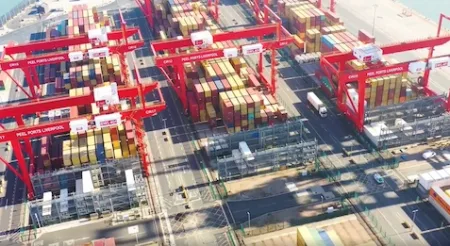Private 5G for port automation
Port infrastructure across Britain urgently requires enhanced connectivity to support the full automation of complex, end-to-end operations. These processes are time-critical, demanding real-time precision from stakeholders.

YET, WITH sensitive data in play and serious risks linked to errors, upgrading legacy systems is no small task. Ensuring long-term digital security while modernising ageing infrastructure calls for robust, future-ready technology that can deliver both operational efficiency and resilience in an increasingly connected, high-stakes environment.
Investment in and the implementation of private 5G (P5G) networks is being explored as a solution to the digital complexities facing port operators today.
Private 5G promises improved coverage and capacity with enhanced service quality and security compared to other wireless network technologies such as public 5G or Wi-Fi. P5G is also highly customisable in line with evolving industry-specific use cases. Additionally, it supports the mission of port staff to retain complete control of their network to keep operations running smoothly without a hitch.
The Peel Ports P5G project has served as a flagship test bed for the UK Government’s ON-SIDE project, where our consortium of public sector, academia, and technology companies work on shared spectrum management and spectrum co-existence topics as well as industry Private 5G use case & business case validations.
While looking to establish a design that could support the proof of technology, the project was initiated to enhance operational efficiency, bolster security and boost scalability, starting with the Port of Liverpool. This would reduce and eventually supersede reliance on public networks, as well as underpinning port automation.
Tasked with undertaking this ON-SIDE project at Peel Ports Group, were Peel Ports Group, Logicalis UK&I, DSIT, Cisco and Intel.
All partners contributed their combined, long-standing services and expertise towards building up and upholding digital connectivity and automation of port logistics and processes, as well as enhancing network security across the port.
Describing the goals of the project, Desmond O’Connor, Business Development Leader at Cisco said, “From the outset, we looked around the UK to determine sectors which could benefit from a P5G, and then, for companies who were ready to make that co-investment to determine whether P5G has a role in their digital strategy.”
The private 5G network incorporates Cisco’s Mobility Services Platform (a cloud-managed 5G core) as well as Cisco’s network switching, computers and 5G industrial gateways connect via Nokia AirScale radio. This is all brought together as a managed service by Logicalis.
Private 5G uses a lightly licensed piece of spectrum, obtained from Ofcom, by Peel Ports Group. Ofcom offers this as a ‘Shared Access Licence’ which is only useable by Peel at their location at that frequency. For ports, these private 5G licensed networks have significant benefits over public 5G or even WiFi. Its IT/OT security integration, coverage per radio, service level guarantees, and large device ecosystem make it attractive to many businesses.
Explaining the task ahead, Frank Rubotham, Head of Solution Specialists and Propositions at Logicalis UK&I said, “From our point of view, it was all about designing the solution to ensure that the use cases across the Port could be fully tested and their success measured. This entails looking at the environment where connectivity is required; undertaking detailed radio planning and simulation exercises; and ultimately getting to a design that would support the proof of technology.
The next phases of this project will be to prove that the technology works to the challenging demands of the Port and that it can support any growth, expansion or change that Peel Ports Group wants to implement. We would see this as the future networking solution of choice across all of the ports.”
Project scope
The initiative was co-funded by Cisco and the UK Department for Science, Innovation and Technology (DSIT), reflecting a shared commitment to digital transformation in critical national infrastructure.
Logicalis UK&I took on the role of key delivery partner and trusted advisor with Intel also contributing in a similar capacity, both in expertise and funding.
With much of the port infrastructure running on Intel CPUs, an opportunity was realised to bring improved connectivity, efficiency and data protection to a critical piece of national infrastructure.

One main challenge to overcome was the maintenance of connectivity between container terminals, which cover an area of approximately 100 acres and the plant at the Port of Liverpool.
Rubotham continued, “Ports are very difficult environments to deliver wireless networks into, with lots of moving machinery and people as well as large metal structures, but P5G has made this much easier; it has reduced the amount of cabling that is required and the number of hardware devices.
But more importantly, it has delivered connectivity right across the port, so that Peel Ports Group can develop this port in terms of efficiency, security and employee safety.”
Julie Rimmer, Technology and Automation Transformation Director at Peel Ports Group explained what they are hoping to gain, “P5G will give us greater control over the connectivity that we need across the port. It will allow us to enhance security, reduce latency, and also restrict bandwidth for certain functions.”
Outcomes and results
The Port of Liverpool previously ran on Wi-Fi network technology, which was prone to interference and subsequent service interruptions.
A more robust solution, underpinned by P5G, was necessary to get up to speed with the efficiency and security needs of Peel Ports Group and its customers, as well as general users of the port.
P5G is overhauling existing systems, which have proved insufficient for straddle carriers when covering long distances. With this new wireless technology in place, the carriers can properly communicate with the rest of the port components in real time.
P5G equipment has been installed on port towers, forgoing the need to build completely new physical infrastructure, boosting sustainability in the process. Three Nokia small cell radios on n77 band point to operating cranes across the port, providing complete coverage without interference or disruption from ongoing movement of metal, which can cause problems for Wi-Fi and other wireless network technologies
The P5G network being utilised by Peel Ports Group oversees and allows for complete control over the cranes and carriers operating across the Port of Liverpool.
Summarising the benefits they have seen, Rimmer commented, “Since we’ve had the installation, we have seen less dropouts around the quayside, so we know there is an improvement in connectivity.”
In addition to enhancing operations across the port, this project has increased connectivity and is ensuring improved worker safety and long-term data security.
Due to the increased bandwidth and decreased latency that P5G brings, compared to Wi-Fi, service dropouts have decreased across the Port of Liverpool.
Meanwhile, network performance has seen 10x improvement due to the surge in bandwidth and low latency involved, and the volume of cables in place onsite has been greatly reduced.
O’Connor added, “This is connecting the cranes and gantry carriers, and in the long term, this could also facilitate push-to-talk and man-down technology on phones, tablets and security cameras. As long as it has a SIM card, it can be connected with P5G.”
Summarising the project and how P5G is now being used across the Port of Liverpool, Damian Cross, Head of Containers Technology & Automation at Peel Ports Group, explained, “We’ve always been constrained in terms of engineering or operations, to get information or data that isn’t always easily accessible. You now have very small devices that you can deploy anywhere, to connect to a network and feed that back instantaneously. This opens the door to so much data-driven information.
Every morning, we sit in 8 o’clock meetings and look at data within our operations. This P5G network delivers this on a plate to us, directly. The amount of equipment we can fit on is now endless.”



